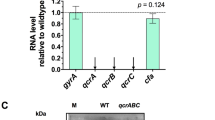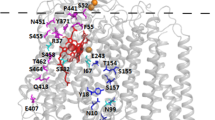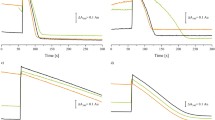Abstract
All pyrroloquinoline quinone (PQQ)-dependent alcohol dehydrogenases contain an unusual disulfide ring formed between adjacent cysteine residues. A mutant enzyme that is lacking this structure was generated by replacing Cys105 and Cys106 with Ala in quinoprotein ethanol dehydrogenase (QEDH) from Pseudomonas aeruginosa ATCC17933. Heterologously expressed quinoprotein ethanol dehydrogenase in which Cys-105 and Cys-106 have been replaced by Ala (Cys105Ala/Cys106Ala apo-QEDH) was successfully converted to enzymatic active holo-enzyme by incorporation of its cofactor PQQ in the presence of Ca2+. The enzymatic activity of the mutant enzyme in the artificial dye test with N-methylphenazonium methyl sulfate (PMS) and 2,6-dichlorophenol indophenol (DCPIP) at pH 9 did not depend on an activating amine which is essential for wild type activity under these conditions. The mutant enzyme showed increased Michaelis constants for primary alcohols, while the affinity for the secondary alcohol 2-propanol was unaltered. Surprisingly, for all substrates tested the specific activity of the mutant enzyme in the artificial dye test was higher than that found for wild type QEDH. On the contrary, in the ferricyanide test with the natural electron acceptor cytochrome c 550 the activity of mutant Cys105Ala/Cys106Ala was 15-fold lower than that of wild type QEDH. We demonstrate for the first time unambiguously that the unusual disulfide ring is essential for efficient electron transfer at pH 7 from QEDH to its natural electron acceptor cytochrome c 550.



Similar content being viewed by others
Abbreviations
- PQQ:
-
Pyrroloquinoline quinone
- QEDH:
-
Quinoprotein ethanol dehydrogenase
- Cys105Ala/Cys106Ala:
-
Quinoprotein ethanol dehydrogenase in which Cys-105 and Cys-106 have been replaced by Ala
- QMDH:
-
Quinoprotein methanol dehydrogenase
- PMS:
-
N-Methylphenazonium methyl sulfate
- DCPIP:
-
2,6-Dichlorophenol indophenol
- LB:
-
Luria broth growth medium
- IPTG:
-
Isopropyl-β-d-thiogalactopyranoside
- EPR:
-
Electron paramagnetic resonance
References
Afolabi PR, Mohammed F, Amaratunga K, Majekodunmi O, Dales SL, Gill R, Thompson D, Cooper JB, Wood SP, Goodwin PM, Anthony C (2001) Site-directed mutagenesis and X-ray crystallography of the PQQ-containing quinoprotein methanol dehydrogenase and its electron acceptor, cytochrome c(L). Biochemistry 40:9799–9809
Anthony C (2004) The quinoprotein dehydrogenases for methanol and glucose. Arch Biochem Biophys 428:2–9
Anthony C, Williams P (2003) The structure and mechanism of methanol dehydrogenase. Biochim Biophys Acta 1647:18–23
Arslan E, Schulz H, Zufferey R, Kunzler P, Thöny-Meyer L (1998) Overproduction of the Bradyrhizobium japonicum c-type cytochrome subunits of the cbb3 oxidase in Escherichia coli. Biochem Biophys Res Commun 251:744–747
Avezoux A, Goodwin MG, Anthony C (1995) The role of the novel disulphide ring in the active site of the quinoprotein methanol dehydrogenase from Methylobacterium extorquens. Biochem J 307:735–741
Bradford MM (1976) A rapid and sensitive method for the quantitation of microgram quantities of protein utilizing the principle of protein-dye binding. Anal Biochem 72:248–254
Chen ZW, Matsushita K, Yamashita T, Fujii TA, Toyama H, Adachi O, Bellamy HD, Mathews FS (2002) Structure at 1.9 Å resolution of a quinohemoprotein alcohol dehydrogenase from Pseudomonas putida HK5. Structure 10:837–849
Diehl A, von Wintzingerode F, Görisch H (1998) Quinoprotein ethanol dehydrogenase of Pseudomonas aeruginosa is a homodimer: sequence of the gene and deduced structural properties of the enzyme. Eur J Biochem 257:409–419
Ghosh M, Anthony C, Harlos K, Goodwin MG, Blake C (1995) The refined structure of the quinoprotein methanol dehydrogenase from Methylobacterium extorquens. Structure 3:177–187
Kay CWM, Mennenga B, Görisch H, Bittl R (2004) Characterisation of the PQQ-cofactor radical in quinoprotein ethanol dehydrogenase of Pseudomonas aeruginosa by electron paramagnetic resonance spectroscopy. FEBS Lett 564:69–72
Keitel T, Diehl A, Knaute T, Stezowski JJ, Höhne W, Görisch H (2000) X-ray structure of the quinoprotein ethanol dehydrogenase from Pseudomonas aeruginosa: basis of substrate specificity. J Mol Biol 297:961–974
Lämmli UK (1970) Cleavage of structural proteins during the assembly of the head of bacteriophage T4. Nature 227:680–685
Matsushita K, Shinagawa E, Adachi O, Ameyama M (1982) O-type cytochrome oxidase in the membrane of aerobically grown Pseudomonas aeruginosa. FEBS Lett 139:255–258
Mutzel A, Görisch H (1992) Quinoprotein ethanol dehydrogenase: preparation of the apo-form and reconstitution with pyrrolloquinoline quinone and Ca2+ and Sr2+ ions. Agric Biol Chem 55:1721–1726
Neu HC, Heppel LA (1965) The release of enzymes from Escherichia coli by osmotic shock and during the formation of spheroplasts. J Biol Chem 240:3685–3692
Oubrie A, Rozeboom HJ, Kalk KH, Huizinga EG, Dijkstra BW (2001) Crystal structure of quinohemoprotein alcohol dehydrogenase from Comamonas testosteroni: structural basis for substrate oxidation and electron transfer. J Biol Chem 277:3727–3732
Reichmann P, Görisch H (1993) Cytochrome c550 from Pseudomonas aeruginosa. Biochem J 289:173–178
Rupp M, Görisch H (1988) Purification, crystallization and characterization of quinoprotein ethanol dehydrogenase from Pseudomonas aeruginosa. Biol Chem Hoppe Seyler 369:431–439
Sambrook J, Fritsch EF, Maniatis T (1989) Molecular cloning: a laboratory manual, 2nd edn. Cold Spring Harbor Laboratory, Cold Spring Harbor
Schobert M, Görisch H (1999) Cytochrome c550 is an essential component of the quinoprotein ethanol oxidation system in Pseudomonas aeruginosa: cloning and sequencing of the genes encoding cytochrome c550 and an adjacent acetaldehyde dehydrogenase. Microbiology 145:471–481
Tetianec L, Dagys M, Kulys J, Ziemys A, Meskys R (2007) Study of the reactivity of quinoprotein alcohol dehydrogenase with heterocycle-pentacyanoferrate(III) complexes and the electron transfer path calculations. CEJB 2:502–517
Xia Z, Dai WW, Zhang Y, White SA, Boyd GD, Mathews FS (1996) Determination of the gene sequence and the three-dimensional structure at 2 angstrom resolution of methanol dehydrogenase from Methylophilus W3A1. J Mol Biol 259:480–501
Xia ZX, Dai WW, He YN, White SA, Mathews FS, Davidson VL (2003) X-ray structure of methanol dehydrogenase from Paracoccus denitrificans and molecular modeling of its interaction with cytochrome c-551i. J Biol Inorg Chem 8:843–854
Acknowledgments
We thank Mrs. I. Maue-Mohn for expert technical assistance. This work was supported in part by grant Go 15-2 from the Deutsche Forschungsgemeinschaft, Bonn, Germany. Plasmid pEC86 was kindly provided by Mrs. Thöny-Meyer, Eidgenössische Technische Hochschule Zürich.
Author information
Authors and Affiliations
Corresponding author
Additional information
Communicated by Arnold Driessen.
Rights and permissions
About this article
Cite this article
Mennenga, B., Kay, C.W.M. & Görisch, H. Quinoprotein ethanol dehydrogenase from Pseudomonas aeruginosa: the unusual disulfide ring formed by adjacent cysteine residues is essential for efficient electron transfer to cytochrome c 550 . Arch Microbiol 191, 361–367 (2009). https://doi.org/10.1007/s00203-009-0460-4
Received:
Revised:
Accepted:
Published:
Issue Date:
DOI: https://doi.org/10.1007/s00203-009-0460-4




